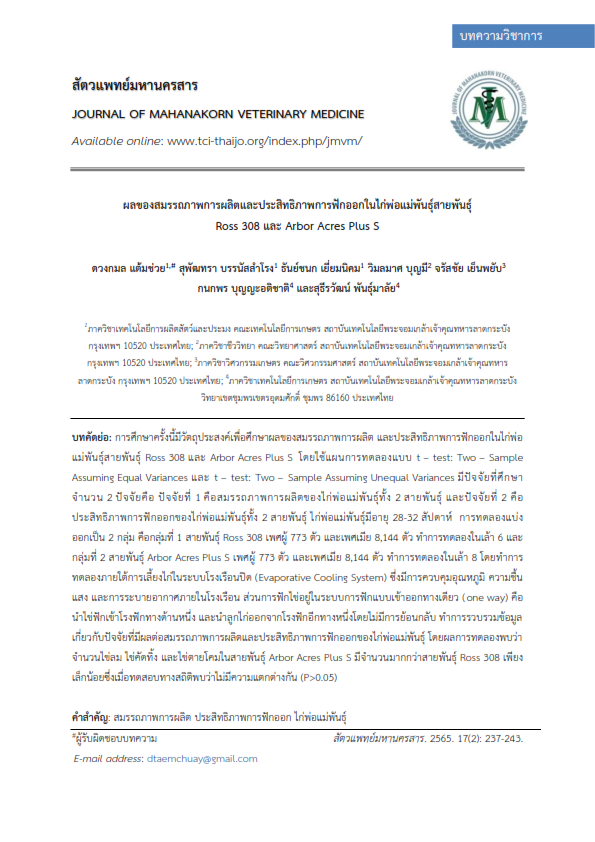Effect of Productivity and Hatchability in Parent Stock Broilers Ross 308 and Arbor Acres Plus S Breeder
Main Article Content
Abstract
This study aims to the effect of productivity and hatchability in parent stock broilers, Ross 308 and Arbor Acres Plus S breeder. Using t – test: two – sample assuming equal variances and t – test: two – sample assuming unequal variances experimental plan. There were two factors that were studied. The first factor was the productivity of both breeder parent stock broilers (Ross 308 and Arbor Acres Plus S). The second factor was the hatchability of both breeder parent stock broilers. Breeder chickens are 28-32 weeks old. This experiment was devided 2 groups. Group 1 is the Ross 308 species, with 773 males and 8,144 females tested in the 6th cage. Group 2 is the Arbor Acres Plus S species, with 773 males and 8,144 females tested in the 8th cage. The experiment was carried out under raising chickens in an evaporative cooling system which controls the temperature, humidity, light, and ventilation inside the house. As for the incubation of eggs, the hatching system is one-way in and out, which is to bring the eggs into the hatchery on one side. And remove the chicks from the hatchery on the other side without going back. Collecting data on factors affecting productivity and hatching efficiency of parent stock broiler chickens. The results showed that the number of infertile eggs, rejected eggs and dead eggs of the Arbor Acres Plus S was slightly higher than that of Ross 308, which was not statistically different when tested (P>0.05).
Article Details

This work is licensed under a Creative Commons Attribution-NonCommercial-NoDerivatives 4.0 International License.
References
กรมปศุสัตว์. 2555. ไข่ไก่พ่อ-แม่พันธุ์ไก่กระทง. (แหล่งที่มา): http://www.acfs.go.th 6 สิงหาคม 2564
บริษัทไทยฟู้ดส์ กรุ๊ป จำกัด (มหาชน). 2558. คู่มือการเรียนรู้การปฎิบัติงานกิจการไก่พ่อ-แม่พันธุ์. สำเนาควบคุม ฉบับที่ 9. สำนักงานใหญ่ อาคารชินวัตร 3 กรุงเทพมหานคร.
ประภากร ธาราฉาย. 2560. การเลี้ยงไก่พ่อ-แม่พันธุ์. เอกสารประกอบการสอนวิชาการผลิตสัตว์ปีก. ภาควิชาสัตวศาสตร์ คณะสัตวศาสตร์และเทคโนโลยีมหาวิทยาลัยแม่โจ้เชียงใหม่.(แหล่งที่มา): http://www.as2.mju.ac.th 6 สิงหาคม 2564
ประภากร ธาราฉาย. 2560. การเลี้ยงไก่พ่อ-แม่พันธุ์. เอกสารประกอบการสอนวิชาการจัดการฟาร์มสัตว์ปีก. ภาควิชาสัตวศาสตร์ คณะสัตวศาสตร์และเทคโนโลยีมหาวิทยาลัยแม่โจ้เชียงใหม่. (แหล่งที่มา): http://www.as2.mju.ac.th 6 สิงหาคม 2564
ประภากร ธาราฉาย. 2560. การผลิตสัตว์ปีก เอกสารประกอบการสอนวิชากายวิภาคและสรีรวิทยาสัตว์ปีก. ภาควิชาสัตวศาสตร์ คณะสัตวศาสตร์และเทคโนโลยีมหาวิทยาลัยแม่โจ้. เชียงใหม่. (แหล่งที่มา): http://www.as2.mju.ac.th 6 สิงหาคม 2564 หน้า 166
ประภากร ธาราฉาย. 2560. โรงฟักไข่และการจัดการโรงฟัก. วารสารการจัดการฟาร์มสัตว์ปีก. (แหล่งที่มา): http://www.as2.mju.ac.th 6 สิงหาคม 2564 หน้า29
AAPS HandBook. 2018. Parent stock handbook. (แหล่งที่มา): http://es.aviagen.com/assets/Tech_Center/AA_Breeder_ParentStock/AAPSHandBook2018.pdf. 6 สิงหาคม 2564


